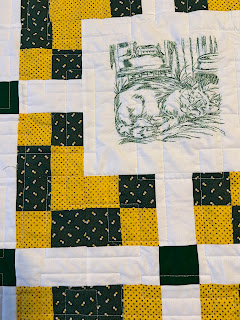Jacket 6 – Lining
Now it is time to tackle the facing, lining and creating the
inside pocket, and collar. The inside
pocket is a welt pocket usually on the right-hand front. When using a full lining, the front lining is
joined to the front/lapel facing. After
joining the facing and lining, I marked and then thread traced the pocket
placement. The thread tracing adds a
step but simplifies the creation of the pocket opening. With the placement lines thread traced on
both the facing/lining and on the pocket piece, it was very easy to line up the
pocket. Once I was satisfied with the
placement, I basted the stitching lines.
Basting may seem unnecessary, but it meant I stitched a nice even box for
the welt. At this point, I took a deep breath
and paused for a couple of days while contemplating slashing the pocket
open. Up to this point, mistakes were
reversible – just a little ripping out of stitches. An error here meant the front would need to
be recut.
After a day or so (and 10 inches of snow) I was sure I had
the pocket correctly placed and stitched.
Scissors in hand, I slashed the pocket open. It folded to the wrong side nicely and the
welt folds lined up at the middle of the opening. Some basting, then stitching and a lot of steam,
and I have a completed pocket (Picture 6-1).
I am now ready to assemble the lining: sew the back seam and press the pleat; sew the side seams; insert the sleeves. Most instructions for lining a jacket tell you to attach the facings; then sew the back and side seams; and finally, to hand stitch the sleeves into the armhole. I don’t trust the strength of my hand sewing. I set the lining sleeves as I did the outer sleeves by machine. This means that the steps to finishing the front and collar are in a different order than in my book or in the pattern instructions.
For the upper collar, the seam allowances are pressed under
(lots and lots of steam) to get nice points.
The upper collar is then sewn to the jacket, right side of collar to
wrong side of the jacket neckline. I
basted again and the collar fit perfectly between the end points for the lapel.
(Picture 6-2) I also marked the shoulder points (not something I usually do)
and the collar matched up. Stitched the
collar to the jacket and now it is truth time.
Will the lining fit the jacket? I
have tried to be very careful and keep my seam allowances accurate because
small deviation in the lining or the jacket seam allowances can mean seams
don’t line up and the lining can be too big (easier to fix) or too small (not
so easy to fix).
In the next post, I will finish the jacket collar, slip
stitch the remaining neck seam, complete the hems, buttonholes, and attach the
buttons. And I will have a jacket.
*This is the 6th post in a series by Sandy Herman about sewing a man's tailored jacket.




It's very well done and it looks professionally made!
ReplyDelete